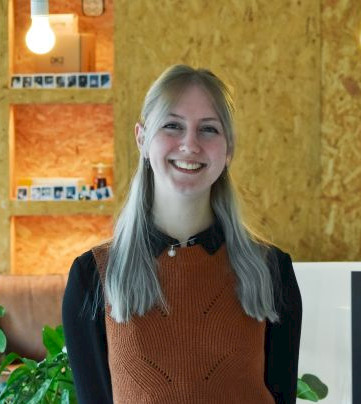About Pim
Pim is one of the Founders of Digitaal Toegankelijk and he was the moral support animal for marieke in this presentation
About Marieke
Marieke is a researcher for Digitaal Toegankelijk. She is an old CMD Student who has her roots in webdesign. But at the company she works she mostly helps other website by testing and researching them, and then writing a report on what can be done to make them more accessible.
Accessibility
Even healthy people sometimes need the accessibility additions that everyone should have in their website, although these are often made for people who experience a handicap.
Some things can happen for example in trains where audio cant be used or someplace outside where the sun is making it hard to read. In these times it is nice to have some accessibility options on your website that can help.
There are also a few things that can happen to someone that would make them temporarily disabled like:
- Breaking your arm or leg
- Medicine
And there are obviously the more permanent disability's like:
- Adhd
- Blindness
- Motor disorder
Whenever you are building a website you should ask yourself these questions:
- Who would i like to exclude?
- Do I like to be left out?
What is Digital Accessibility
Digital accessibility is the way you build your website properly for everyone to access. This way people with disability's can also use your website properly in their own way. There are some guidelines you should follow if you want your website to be accessible. These are the WCAG: Web Content Accessibility Guidelines.
There are 50 criteria, which is a lot and they're divided in 4 principles:
- Perceivabe
- Operable
- Understandable
- Robust
“The Big Four”
Within these 4 principles are also 4 guidelines that are most important Marieke liked to call the "The Big Four".
1.4.2 - Audio Control
Sound playback should be able to be paused if it is longer than 3 seconds.
2.1.2 - No keyboard Trap
When navigating with the keyboard, you should not get stuck.
2.2.2 - Pause, Stop and Hide
Moving and flashing elements that start automatically, last longer than 5 seconds and are shown in parallel. Must be able to be paused, hidden or stopped.
2.3.1 - Three Flashes or Below Threshold
An element must not flash 3 times or more within a second.
Low Hanging Fruit
There is also some low hanging fruit in the guidelines. These are some guidelines that are easily followed if you know about them in advance of a project. These are the low hanging Guidelines:
Can the content be perceived by everyone?
- Is it visible to everyone.
- Is it still visible with large text size and zoom level.
Can the content be reached and used by everyone
- Is it navigable with keyboard.
- Is it navigable with search, for example.
Can the content be understood by everyone
- Is the language well indicated in your page (html long)
- Is the technology behind my digital product constructed semantically correctly
Are the semantic elements good
You should also try to navigate the site in a few different ways, Like with a screenreader and with the keyboard. And after the project is complete you should walk through all the pages with your target audience to see if anything is still missing.
Reflection
This presentation was really good to listen to since it talked about accessibility in the web these days. Especially since the guidelines are becoming stricter every day. Soon you will have to have the guidelines opened on a tab whenever you're creating websites because it is a necesity.
For my selfimprovement
I learned a lot from this presentation like using the big four and the WCAG in my projects to make it just that little bit more accessible. The rest of the presentation was repeating a lot, but that just shows how important it is for everyone.
